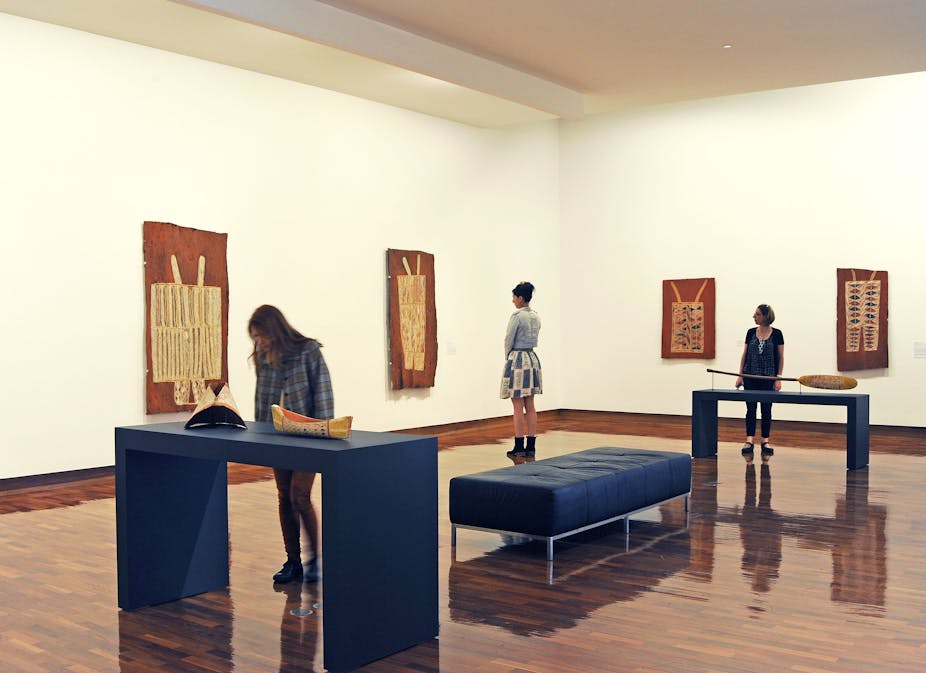Just outside the level-two gallery at the Ian Potter Museum of Art in Melbourne, four black and white photographs capture young Aboriginal men posing with intricate designs on their shoulders, torsos, and thighs.
The designs on their bodies form part of the Warramiri Yolgnu peoples’ madayin minytji [sacred clan designs]. Taken by anthropologist Donald Thomson in the 1930s, the photographs set the context for the extraordinary experience that is the Transformations: Early Bark Paintings from Arnhem Land exhibition.
The exhibition of 24 bark paintings, three objects, and four photographs confronts the participant with the obligations of being invited to view the sacred.

Contrary to the many Indigenous items in museums that were stolen from communities, the early bark paintings from Central and Eastern Arnhem Land, Caledon Bay and Groote Eylandt in the Northern Territory were painted and given to Thomson in the 1930s and 1940s, and to Leonhard Adam in the 1950s.
These gifts reflected the trust that the researchers had established with Anindilyakwa and Yolngu elders, but also their obligations. As described on the exhibition wall panels, the clan leaders approved the transcription onto bark of the sacred designs painted onto men’s bodies with the explicit intent to:
convey to outsiders the complexity and value of Yolngu [and Anindilyakwa] culture and its deep connection to land.
One wonders what it meant for the Yolngu and Anindilyakwa clan elders to invite Thomson and Adam into their sacred worlds. To experience the power that emanates from Mundukul Marawili’s “Mundukul [Snake] Story and Yirwarra [Fish Trap],” one wonders what it means to invite people to view their sacred worlds today?

The bark paintings exhibition fills two galleries. The first gallery consists of four groupings:
1) Macassan prau (large sailing vessels from now Sulawesi, Indonesia) paintings from the 1940s of the Anindilyakwa language group
2) Macassan prau paintings from the 1930s of the Anindilyakwa language group
3) Ritharngu madayin minytji from the 1940s
4) the collaborative painting “Djambuwal [Thunderman]” co-created by Wonnggu Mununggurr and his three eldest sons in the 1940s.
The second gallery consists of five groupings:
1) marrnggitj [medicine-men/healer] paintings from the 1930s
2) madayin minytji from Liyagawumirr, Balmbi, and Walamangu clans from the 1930s
3) madayin minytji from the Djapu, Madarrpa, and Munyuku clans from the 1940s
4) madayin minytji by Makani Wilingarr of the Mildjingi clan from the 1930s
5) painted paddles, model boats and fish traps from Milingimbi, Madarrpa, and Mildjingi or Djinang clans, respectively dating from the 1940s—1950s.
Although the “Djambuwal” collaborative painting is meant to be the show-stopper in the first gallery, the Macassan paintings compel the viewer with their detailed depictions of the prau, the human figures on their decks, and the sea creatures, such as sea cucumber, fish, jellyfish, turtles, or whales that were traded between the Anindilyakwa peoples and the Macassans.
Minimini Numalkiyiya Mamaika’s “Turtles (Yimenda) Eating Jelly-Fish (Armbulirra)” exemplifies the use of lines, dots, and cross-hatching (rarrk) in these secular paintings. Expressing the connection of the Anindilyakwa peoples to the sea, the Maccassan paintings employ minimalist use of rarrk compared to the madayin minytji.
The exhibition wall panel notes that the Anindilyakwa peoples had been producing “tourist art” on bark for visitors to the Qantas re-fueling station on their island since 1938. Possessing a closed knowledge system, they already controlled the amount of sacred knowledge that they expressed in their paintings.
This is what makes the gift of the madayin minytji bark paintings so exceptional, especially those in the second gallery. The intricate rarrk of the different clans’ madayin minytji conveys the sacred power of the Yolngu ancestors (wangarr) whose actions create their world.

One notes the common motif of water in the paintings. The two most striking bark paintings are Makani Wilingarr’s “Ngarra Minytji no.1 [Ngarra Ceremony Design]”, with its triangular monsoon cloud motif; and Maama Mununggurr’s “Djan’kawu Sisters Story: Djarrka [Water Monitor Lizard],” with its intricate rarrk of monsoon clouds reflected on the backs of the djarrka.

Why did the Anindilyakwa and Yolngu elders risk sharing their sacred knowledge so that we can experience it almost 75 years later? When a person stands in front of a madayin minytji, she experiences a figure emanating from the gestalt of the vibrancy of the bark coated in ochre and the human abstractions of the designs.
In that moment, the madayin minytji connects that person to its embodiment of the ancestors and the land, so that she gains respect for the Anindilyakwa and Yolngu ways of being.
Perhaps, this respect, in terms of recognising the intrinsic worth of those ways of being on their own terms and with complete self-determination, is the obligation of the invitation to view the sacred.
Transformations: Early Bark Paintings for Arnhem Land runs until February 23, 2014 at the Ian Potter Museum of Art, Melbourne.
A free panel discussion on Transformations will take place at the gallery on November 30.

